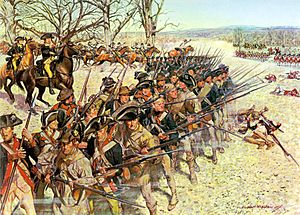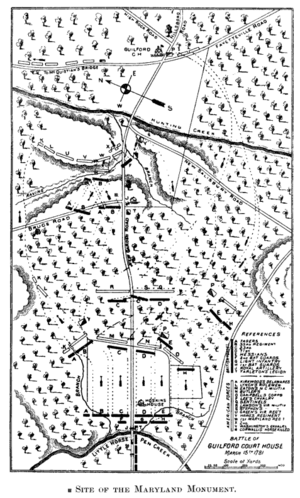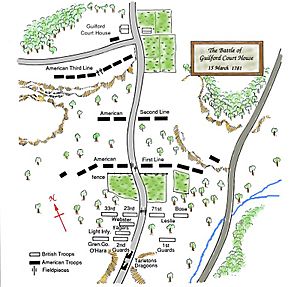Battle of Guilford Court House facts for kids
Quick facts for kids Battle of Guilford Court House |
|||||||
|---|---|---|---|---|---|---|---|
| Part of the American Revolutionary War | |||||||
 Battle of Guilford Court House, H. Charles McBarron Jr. |
|||||||
|
|||||||
| Belligerents | |||||||
| Commanders and leaders | |||||||
| Strength | |||||||
| 2,100 | 4,500 | ||||||
| Casualties and losses | |||||||
| 93 killed 408 wounded 25 missing or captured |
79-94 killed 184-211 wounded 75 wounded prisoners |
||||||
The Battle of Guilford Court House was a big fight during the American Revolutionary War. It happened on March 15, 1781, in a place that is now Greensboro, North Carolina.
About 2,100 British soldiers, led by General Charles Cornwallis, fought against 4,500 American soldiers. The American forces were commanded by General Nathanael Greene. Even though the British won the battle, they lost a lot of their soldiers. This kind of victory, where you win but lose too much, is called a Pyrrhic victory.
This battle was one of the biggest and toughest fights in the southern part of the war. After the battle, General Greene moved his army to South Carolina. General Cornwallis decided to march his army into Virginia. He wanted to join up with other British troops there.
Because of these choices, Greene was able to take back control of the South from the British. Cornwallis's march eventually led him to Yorktown. There, he was forced to give up to General George Washington and French General Comte de Rochambeau.
Today, you can visit the Guilford Courthouse National Military Park. It helps us remember this important battle.
Contents
Why the Battle Happened
After an earlier battle called the Battle of Cowpens, General Cornwallis really wanted to defeat General Greene's army. He even burned his own supplies to make his army lighter and faster. This way, they could chase Greene more easily.
Cornwallis chased Greene in what was called the "Race to the Dan." But Greene managed to escape across the Dan River into Virginia. The river was flooded, which helped Greene get away safely.
Cornwallis then set up camp in Hillsborough. He tried to find food and get people in North Carolina to join the British side. But his army looked very tired and worn out. Also, a sad event called Pyle's Massacre made many local people not want to join the British.
Meanwhile, General Greene got more soldiers to join his army. He decided to cross the Dan River again and challenge Cornwallis. On March 15, the two armies met near Guilford Court House, North Carolina. This is where the big battle took place.
How the Battle Unfolded
The fighting started on the morning of March 15. The first clash happened between small groups of soldiers near a Quaker church. When more British soldiers arrived, the American leader, Light Horse Harry Lee, told his men to go back to Greene's main army.
General Greene had set up his defense in three lines. The first line was made up of soldiers from North Carolina. On their sides, there were skilled riflemen who could shoot at the British from far away. The second line had soldiers from Virginia. The last line was made up of Greene's best and most experienced soldiers.
Greene's plan was similar to a successful one used by Daniel Morgan at the Battle of Cowpens. However, Greene's lines were very far apart. This meant they could not easily help each other during the fight.
The British started their attack around 1:30 PM after a twenty-minute cannon attack. The British army fought hard through the first two lines of American defense. They lost many soldiers doing this. The thick woods and wide battlefield made it hard for the British to stay together. Because of this, British groups arrived at the third line at different times.
The battle became very intense at the third line. British Guards and American soldiers fought hand-to-hand. General Cornwallis made a risky choice. He ordered his cannons to fire special shots called grapeshot across the battlefield. This was dangerous because it could hit his own soldiers. Many British soldiers were killed, but the Americans eventually had to retreat.
During the battle, General Cornwallis had his horse shot out from under him. An American officer, Colonel Benjamin Williams, was later honored for his bravery in the fight.
What Happened After the Battle
The British won the battle because they took control of the ground. But they lost almost 600 men. This was a huge loss for them. A British politician, Charles James Fox, called it a Pyrrhic victory. He said, "Another such victory would ruin the British Army!" This meant that even though they won, the cost was too high.
General Greene was careful not to lose his army completely, like in an earlier battle called Battle of Camden. He retreated with his army still mostly together. Cornwallis's army was now very small, with less than 2,000 soldiers. He decided not to chase Greene into the countryside.
Instead, Cornwallis went back to Hillsborough, North Carolina. He tried to get people to support the British king. For a short time, it seemed like he controlled Georgia and the two Carolinas. But a few weeks later, he left the middle of North Carolina. He marched his army to the coast at Wilmington, North Carolina. He wanted to get more soldiers and new supplies there.
At Wilmington, Cornwallis made a very important decision. He decided to march his army into Virginia. He believed that until Virginia was under British control, he couldn't truly hold the southern states. This decision was later criticized by another British general, General Clinton.
Meanwhile, General Greene did something bold. Instead of following Cornwallis to the coast, he marched his army towards Camden and Charleston, South Carolina. He wanted to draw Cornwallis back to the areas he had fought in before. He also wanted to push back Lord Rawdon, another British commander Cornwallis had left behind.
Greene's main goal was to take back the southern states. He succeeded by the end of the year, but it was not easy. He had many tough fights and some losses. He famously said, "We fight, get beaten, and fight again." On April 25, 1781, Lord Rawdon surprised Greene's camp at Hobkirk's Hill, near Camden. Greene was defeated, but both sides lost about the same number of soldiers.
Cool Facts About the Battle
- The battle was very short, lasting only about 90 minutes.
- The British won, but they lost many more soldiers than the Americans.
- The British victory was called a Pyrrhic victory. This means that even though they won, they lost so many soldiers that it hurt their chances of winning the overall war.
- Banastre Tarleton, a British officer, lost two fingers from his right hand during the battle.
Legacy of the Battle
Every year, around March 15, people dress up in old uniforms. They show how soldiers fought during the Revolutionary War. This happens at or near the battle site. A large part of the battlefield is now the Guilford Courthouse National Military Park, which was created in 1917.
Some parts of the United States Army National Guard today can trace their history back to the American units that fought at Guilford Courthouse. Only about thirty Army National Guard and active Regular Army units have roots going back to the colonial era.
On March 13, 2016, a special monument was opened at the Guilford Courthouse National Military Park. It honors the British officers and soldiers who fought under Cornwallis.
The town of Gilford, New Hampshire, is named after this battle. There was a small spelling mistake in the name, but it still remembers the battle. A New Hampshire historical marker there, number 118, tells the story of how the town got its name.
Images for kids
-
Letter from George Washington to the Comte de Rochambeau (March 31, 1781). In this letter, Washington shares the first news he heard about the Battle of Guilford Court House.
See also
 In Spanish: Batalla de Guilford Court House para niños
In Spanish: Batalla de Guilford Court House para niños






